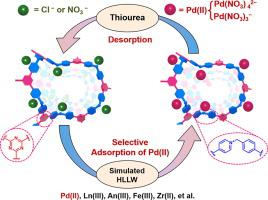Chemical Engineering Journal ( IF 15.1 ) Pub Date : 2021-09-24 , DOI: 10.1016/j.cej.2021.132618 Xiangyang Yuan 1 , Ying Wang 1 , Pengcheng Wu 1 , Xue Ouyang 1 , Wanke Bai 1 , Yaoshuang Wan 1 , Lihua Yuan 1 , Wen Feng 1

|
The recovery of platinum group metals (PGMS) from high-level radioactive liquid waste (HLLW) not only has a complementary role in alleviating the shortage of rare precious metals but also is helpful for the final disposal of radioactive waste. In this work, a new cationic covalent triazine framework (CTF) named as cationic pyridyl triazine polymeric network (CPTPN) is designed and synthesized by ZnCl2-catalyzed ionothermal method for recovering of Pd(II) from HLLW. The excremental results shows that palladium can be efficiently adsorbed by CPTPN from 3 M HNO3 solution via anion exchange with fast adsorption kinetics with adsorption equilibrium reached in 10 min. The adsorption isotherm for Pd(II) follows the Langmuir model, which reveals the maximum adsorption capacity (qm) of 339.8 mg g−1 and 389.7 mg g−1 at 3 M HNO3 for CPTPN-Cl and CPTPN-NO3 , respectively. Further studies show that the qm of CPTPN-NO3 in 6 M HNO3 can reach a higher level at 428.6 mg g−1, which is the highest record for Pd(II) recovery in 6 M HNO3. In addition to high thermal stability, CPTPN exhibits a good irradiation stability with excellent adsorption performance maintained after 1000 kGy of γ-irradiation. Furthermore, CPTPN has an excellent adsorption selectivity for Pd(II) in simulated HLLW. Although the selectivity of CPTPN-Cl for Pd(II) is found to be unsatisfactory due to the significant co-adsorption of Ag(I), this problem can be well solved by changing Cl− ions in CPTPN-Cl to NO3−. Both CPTPN-Cl and CPTPN-NO3 show excellent reusability in 5 adsorption–desorption cycles. Thus, CPTPN can be considered as a candidate adsorbent that can tolerate high irradiation and high acidity for selective recovery of Pd(II) from HLLW.
中文翻译:

用于从核裂变产物中回收 Pd(II) 的高酸度和抗辐射三嗪基持久性有机污染物
从高放射性废液(HLLW)中回收铂族金属(PGMS)不仅对缓解稀有贵金属短缺有补充作用,而且有助于放射性废物的最终处置。在这项工作中,通过 ZnCl 2催化的离子热法设计并合成了一种名为阳离子吡啶基三嗪聚合物网络 (CPTPN) 的新型阳离子共价三嗪骨架 (CTF),用于从 HLLW 中回收 Pd(II)。排泄物结果表明,CPPTN 可以通过阴离子交换从 3 M HNO 3溶液中有效吸附钯,吸附动力学快速,吸附平衡在 10 分钟内达到。Pd(II) 的吸附等温线遵循 Langmuir 模型,该模型揭示了最大吸附容量 ( qm )对于 CPTPN-Cl 和 CPTPN-NO 3,分别为 339.8 mg g -1和 389.7 mg g -1在 3 M HNO 3 下。进一步的研究表明,CPPTN-NO 3在 6 M HNO 3中的q m可以达到更高的水平,达到 428.6 mg g -1,这是 6 M HNO 3 中Pd(II) 回收率的最高记录. 除了高热稳定性外,CPPTN 还表现出良好的辐照稳定性,在 1000 kGy γ 辐照后仍保持优异的吸附性能。此外,CPPTN 在模拟 HLLW 中对 Pd(II) 具有出色的吸附选择性。尽管发现 CPTPN-Cl 对 Pd(II) 的选择性由于 Ag(I) 的显着共吸附而不能令人满意,但是通过将CPTPN-Cl 中的Cl -离子改变为 NO 3 -可以很好地解决这个问题。CPTPN-Cl 和 CPTPN-NO 3在 5 次吸附-解吸循环中均显示出优异的可重复使用性。因此,CPPTN 可以被认为是一种候选吸附剂,可以耐受高辐射和高酸度,用于从 HLLW 中选择性回收 Pd(II)。


























 京公网安备 11010802027423号
京公网安备 11010802027423号